Key takeaways:
- Leftover ingredients should be viewed as opportunities for creativity, transforming potential waste into new meals through experimentation and a shift in mindset.
- Repurposing leftovers offers multiple benefits, such as cost efficiency, nutritional value, time savings, creative exploration, and a positive environmental impact.
- Implementing effective storage practices, composting, and utilizing leftover scraps contribute to reducing food waste and fostering eco-friendly habits in the kitchen.
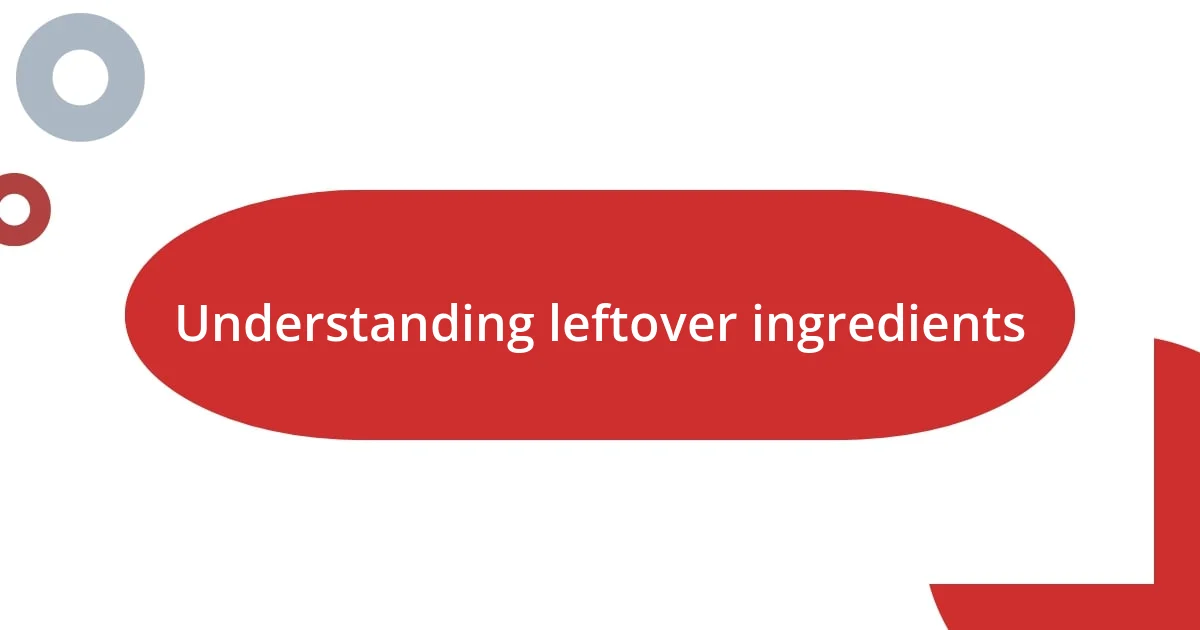
Understanding leftover ingredients
Leftover ingredients often remind me of culinary opportunities waiting to be discovered. I’ll never forget the time I found half a bell pepper languishing in my fridge. Instead of letting it wilt away, I diced it up and tossed it into a frittata, transforming what could have been waste into a vibrant breakfast that felt like a small victory.
Understanding these remnants starts with recognizing their potential. Take the last spoonful of that savory pasta sauce—why not add it to a soup or drizzle it over roasted vegetables? I often ponder, what if we viewed leftover ingredients as the beginnings of new meals rather than remnants of old ones? It requires a shift in mindset, but once you start seeing the value in your leftovers, it opens up a realm of creativity that can be both fulfilling and delicious.
Sometimes, I approach my fridge as if I’m a contestant on a cooking show, challenged to create something exciting from what remains. The thrill of experimenting with what’s on hand can lead to delightful surprises—like the time I mixed together leftover rice, black beans, and a bit of salsa to create a spontaneous and flavorful dinner. Embracing these moments can ignite a passion for cooking that’s not just about the result but about the journey of transforming what you have into something entirely new.
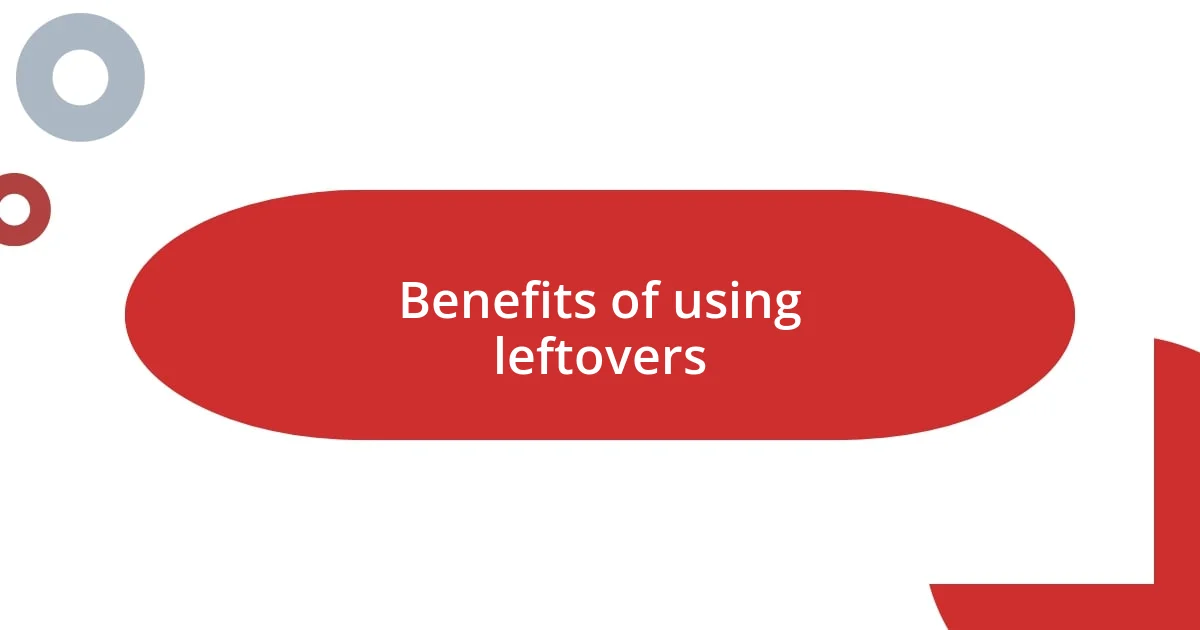
Benefits of using leftovers
Using leftovers can spark not just creativity but also a sense of accomplishment. Every time I repurpose an ingredient, it’s like uncovering a treasure I didn’t even know I had. I remember one night when I had just a few strips of grilled chicken left over from a barbecue. Instead of warming them up as a simple reheat, I chopped them into bite-sized pieces and tossed them into a homemade tortilla soup. The result was comforting and satisfying, reminding me how little can create something extraordinary.
Embracing leftovers comes with numerous benefits, including:
- Cost Efficiency: It saves money by reducing food waste and maximizing what you already have.
- Nutritional Value: Leftovers can often contain a variety of nutrients and flavors, promoting a balanced diet.
- Saves Time: Cooking with leftovers cuts down on prep time, allowing for quicker meal solutions.
- Creative Exploration: It encourages experimentation, pushing you to try new flavor combinations and techniques.
- Environmental Impact: Reducing waste contributes to sustainability, helping you feel good about your food choices.
I find it incredibly rewarding to know I’m doing my part to combat food waste while discovering delicious new meals in the process.
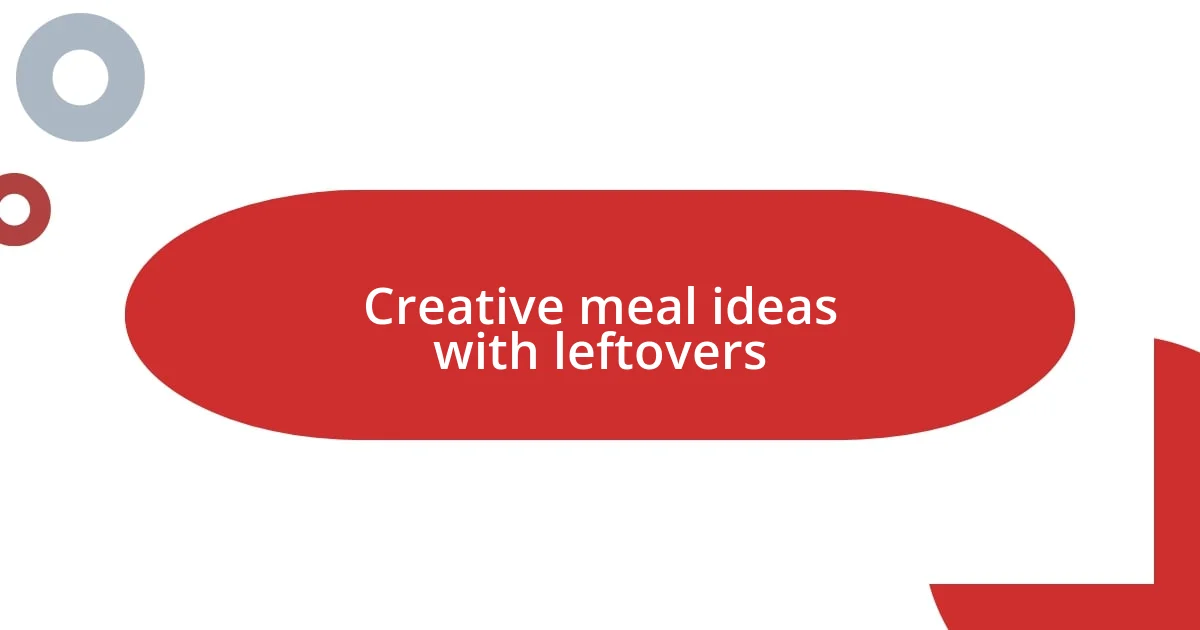
Creative meal ideas with leftovers
One of my favorite ways to use leftovers is to make a hearty stir-fry. I recall the delight I felt when I stumbled upon a mix of leftover vegetables and some day-old rice. The vibrant colors of broccoli, carrots, and snap peas came together in a hot skillet with a splash of soy sauce and a sprinkle of sesame seeds. In just a few minutes, I had a meal that tasted fresh and was packed with flavor. It reminded me that creativity can thrive even when time is of the essence.
Another delightful idea I’ve come to love is crafting a fusion dish. I recently had some leftover roasted sweet potatoes and cooked quinoa, and I thought, why not combine them into a savory salad? Tossing them together with a squeeze of lime, some fresh cilantro, and a hint of cumin led to a colorful, nutritious dish that perfectly showcased what I had on hand. It was not just a meal; it was an experience that highlighted the importance of flavors coming together in unexpected ways.
Lastly, when it comes to building hearty soups, leftovers can be truly transformative. I remember having some overcooked pasta that didn’t quite have the texture I wanted anymore. Instead of tossing it, I sautéed some onions, added diced tomatoes, and poured in a broth I had in the freezer. Adding the pasta to the pot created a warm, comforting soup that warmed me up on a chilly evening. It’s incredible how a bit of imagination can turn what might have been a disappointment into a cozy dish that feels like a hug in a bowl.
| Leftover Ingredients | Creative Meal Ideas |
|---|---|
| Cooked Rice | Stir-Fry with vegetables and soy sauce |
| Grilled Chicken | Tortilla Soup |
| Sweet Potatoes | Savory Quinoa Salad |
| Overcooked Pasta | Hearty Soup |
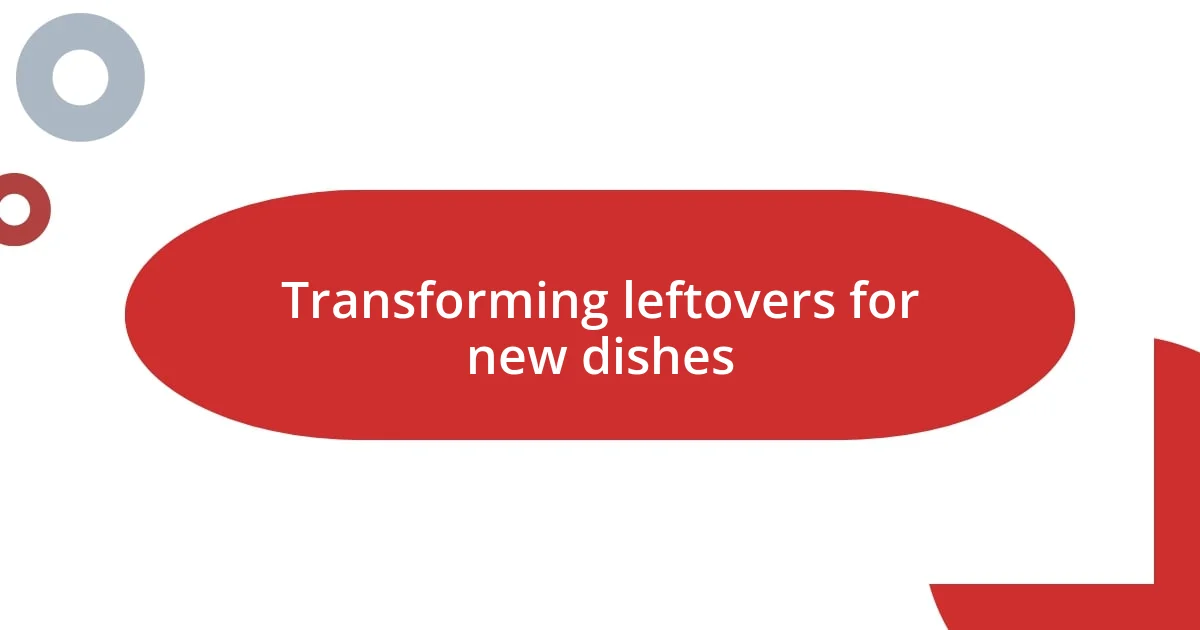
Transforming leftovers for new dishes
When it comes to transforming leftovers, I love creating unique breakfast dishes. One morning, I found some leftover sautéed spinach and feta cheese in the fridge. Instead of a typical egg scramble, I decided to mix the ingredients into a frittata. The result? A fluffy, flavorful dish that brightened my day—I couldn’t help but feel proud of the inventive twist on breakfast.
Another fun approach I often take is turning dinner leftovers into a hearty dip. I once had a half jar of roasted red pepper sauce left, paired with some day-old garlic bread. I blended them together with a bit of cream cheese, and suddenly I had a delicious dip that I served with crispy veggie sticks. This not only revitalized ingredients I might have overlooked, but it also entertained friends with a new snack. Isn’t it amazing how creativity can turn an ordinary evening into a memorable gathering?
I also find that blending leftover grains into new meals can be surprisingly effective. After a week of having quinoa on the side, I created a breakfast bowl by mixing it with yogurt and fresh fruit. It became my go-to morning treat! I felt invigorated and energized, plus it was so rewarding to see how simple grains could evolve into something entirely different. Have you ever had a similar moment, transforming everyday ingredients into something special? It’s like turning the mundane into magic.
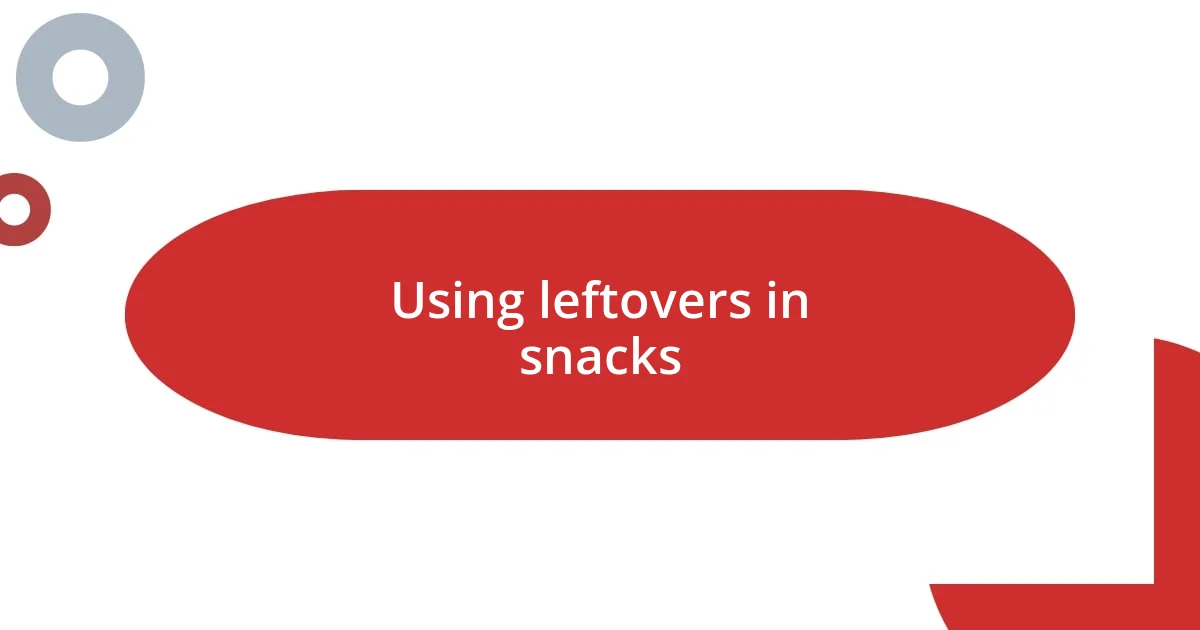
Using leftovers in snacks
I often find that leftover ingredients can lead to incredibly satisfying snack creations. Just the other day, I discovered some leftover roasted vegetables tucked away in my fridge. Instead of letting them go to waste, I whipped up a quick veggie quesadilla. The combination of melting cheese with those sweet roasted flavors created such a comforting snack; it reminded me that culinary surprises often lie in what we already have. Have you ever thought of your snacks as opportunities for discovery?
Sometimes, I am pleasantly surprised by how leftovers can become new dips. When I had a scoop of hummus left over from a party, I added a handful of herbs I had and a squeeze of lemon juice. What emerged was a bright, zesty dip that breathed new life into my snack routine. I served it with crunchy carrot sticks, and the whole experience was delightful! It’s moments like this that make me realize how a little creativity can transform the mundane into something remarkably enjoyable.
And let’s not forget about sweet treats. I once had some overripe bananas that were starting to look a bit sad. Instead of tossing them in the trash, I mashed them up and mixed them with some oats and a dash of cinnamon to make energy bites. These little snacks turned out to be not only nutritious but incredibly delicious too! Every bite was a reminder of how leftovers could lead to delightful surprises—who wouldn’t want a snack that feels wholesome and indulgent at the same time?
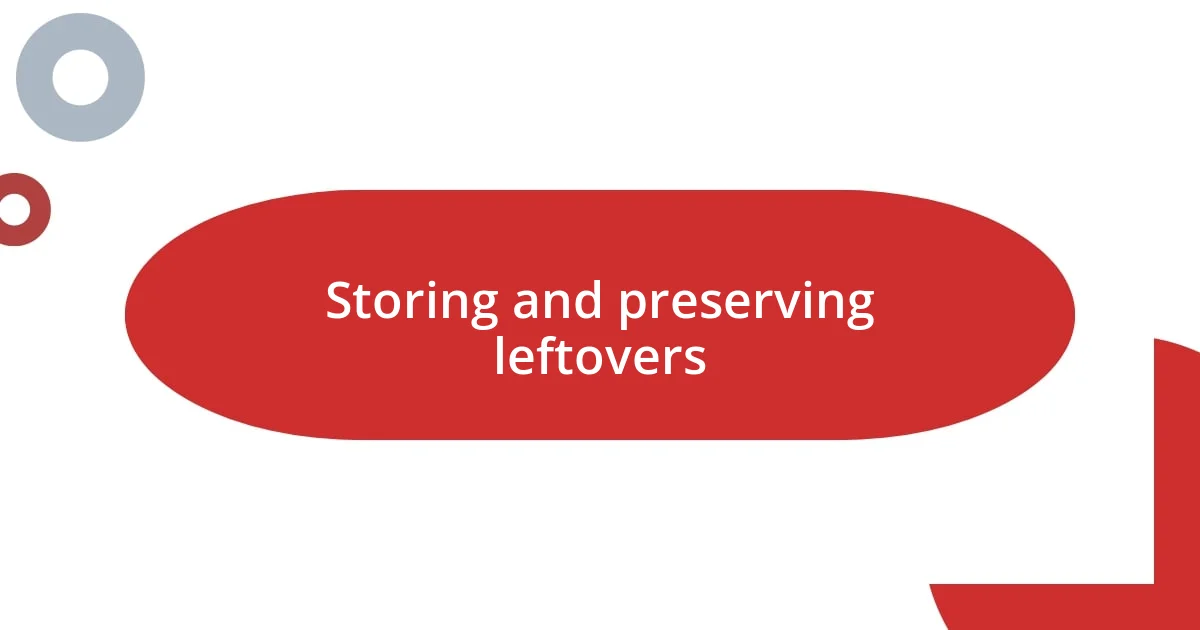
Storing and preserving leftovers
Storing leftovers properly is essential to keep them fresh and tasty. I’ve learned that using airtight containers can significantly prolong the life of my food. When I pack away chicken or beans, I make sure to remove any air before sealing them tight. It’s a small effort that pays off—there’s nothing like opening the fridge and seeing vibrant, appealing meals ready to enjoy.
I’ve also discovered the magic of freezing leftovers. One time, I had a big batch of tomato sauce left after a family dinner. Instead of letting it languish in the fridge, I poured it into ice cube trays and froze it. Now, whenever I’m in the mood for a pasta dish, I can simply grab a few cubes, toss them in a pan, and have a homemade sauce in minutes. Isn’t it amazing how a little foresight can turn a busy evening into a gourmet experience?
Additionally, labeling is an often-overlooked key to effective storage. I remember the first time I opened my freezer and found an unidentifiable container buried inside. It was a guessing game! Now, I always write the date and what’s inside with a marker. This little habit keeps my fridge organized and reminds me to enjoy my leftovers before they become a mystery. Have you ever played “what’s-in-the-container?” It’s much more satisfying knowing exactly what awaits you!
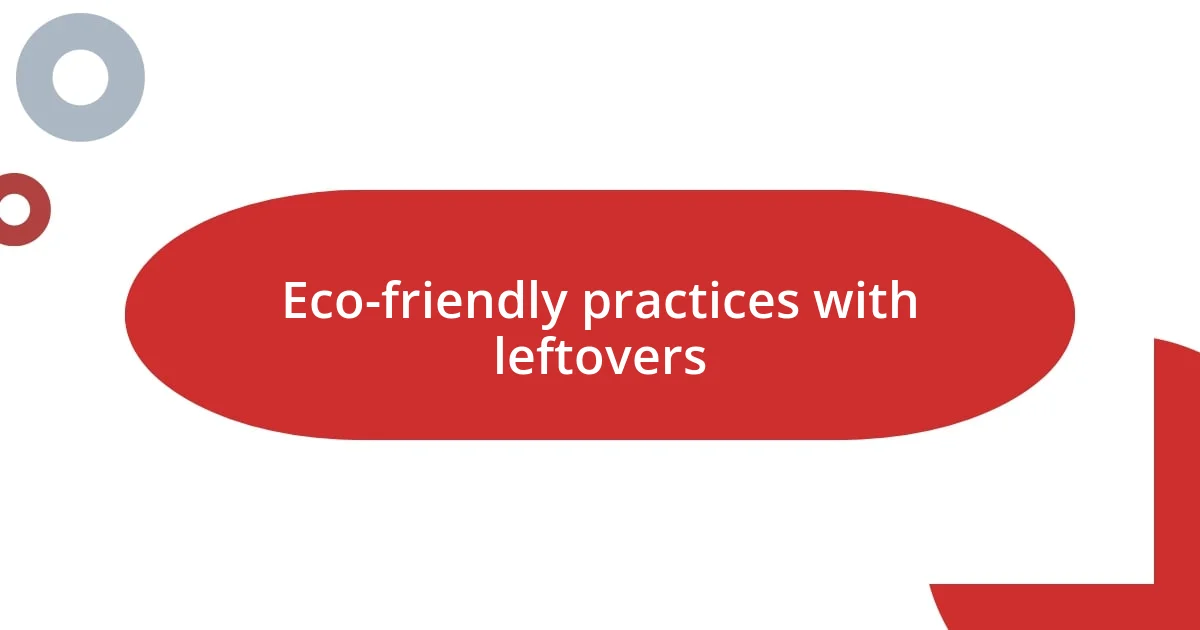
Eco-friendly practices with leftovers
I often think about the impact of food waste on the environment. Once, after making a huge batch of vegetable soup, I had quite a bit left over. Instead of simply reheating it, I used the leftover soup as a base for a rice dish the next day. It not only saved me time but also turned what could have been waste into a flavorful meal, showing me how ingenuity with leftovers can reduce our carbon footprint while nourishing our bodies.
Another eco-friendly practice I’ve adopted is composting. A while back, I started saving scraps like vegetable peels and coffee grounds in a small container. Turning these leftovers into compost felt so rewarding! Not only does it enrich my garden soil, but it also closes the loop in my kitchen by ensuring scraps serve a new purpose instead of heading straight to the landfill. Have you tried composting? It’s a great way to give your leftovers a second life!
I also keep a jar in my fridge designated for leftover herbs and veggie bits. When it fills up, I throw everything into a pot with some stock to create a hearty stew. I remember feeling the satisfaction of using what would usually end up in the trash to create a warm meal. It’s a win-win—saving money and reducing waste! Isn’t it incredible how little changes can lead to such a positive impact on both our environment and our dinner table?















